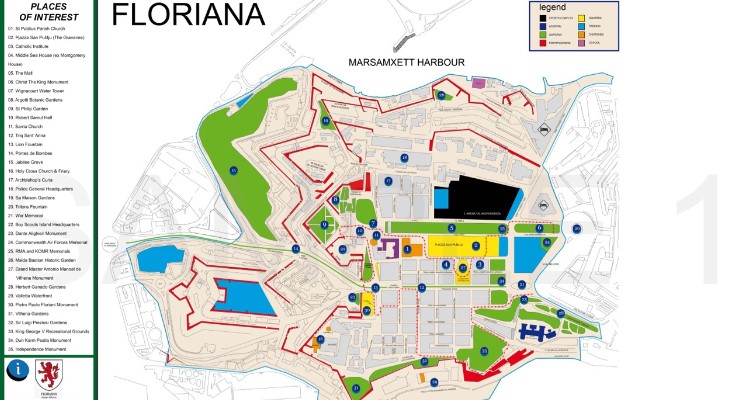Often overshadowed by its more famous neighbour Valletta, the historic garden city of Floriana is a gem to discover.
The small town of Floriana, right on the doorstep of the capital Valletta, boasts the largest square in Malta, the largest number of public gardens anywhere in Malta and the most monuments of national importance on the island by some of Malta’s most prestigious artists - that’s a lot of superlatives for a town of just 2,600 residents.
Add to that numerous churches and other historic buildings which provide an insight into Malta’s political and social history from the time of the Knights of St John till today. Oh, and you can explore all that within a 90-minute walk. Let’s go.

We kick off our tour at the Monument to Christ the King, at the very edge of Floriana’s boundary with Valletta off Triton Place. Floriana was built on the recommendation of Italian engineer Pietro Paolo Floriani, who was brought over by Grand Master Antoine de Paule in 1634 to assess the safety of Valletta. The Grand Master was worried about another attack by the Ottoman Turks, and Floriani suggested the city’s fortifications should be protected with a further set of fortifications to ensure the enemy could not see directly into the capital.
The 4km extension out to Portes des Bombes was completed in 1721, and a year later, the new Grand Master Antonio Manoel de Vilhena decreed the new town should be called Borgo Vilhena. But the name never caught on, as the residents insisted on calling their hometown Floriana. And the name stuck.
The Christ the King Monument by renowned Maltese sculptor Antonio Sciortino is in Biskuttin, literally small biscuit, just one of 15 gardens in Floriana. To the left, you'll spot the Commonwealth Air Forces Memorial topped by a shining bronze eagle symbolising airmen who died in flight. At the foot of the monument are listed the names of 2,301 victims of World War II.
Head straight to the Independence Monument at the gates of The Mall, the oldest garden in Floriana, and once the exclusive recreation area of the Knights of St John. The 400m long garden runs the entire length of the Granaries, officially known as St Publius Square, the largest square in Malta. There are 76 granaries in the square, which continued to provide grain to the starving population during World War II.
Walk across the Granaries to salute the founder of Floriana, Grand Master de Vilhena. Don’t dismiss that insurance office block named Middle Sea House next to de Vilhena’s statue. That building dates back to de Vilhena’s time, and it was here that Winston Churchill and US President Roosevelt met before leaving for their meeting with Stalin at Yalta!
Crowning the top of the Granaries is Floriana’s parish church dedicated to St Publius, the first Maltese to be converted to Christianity by St Paul during his short stay in Malta in AD60.
Walk along Triq Sarria which runs between the church and The Mall to Wignacourt Water Tower, commemorating the opening of the aqueduct system in 1615, which brought water by gravity from high grounds around Mdina and Rabat to Floriana and Valletta.
Argotti Botanic Gardens and St Philip Garden behind the water tower are currently closed for refurbishment, so you will have to return later this year to explore them. But, across the road is a gem of a church, the rotunda of Sarria - the only church designed by Mattia Preti containing seven masterpieces by il Calabrese himself. Opposite is the whimsical neo-gothic Robert Samut Hall built in 1883 as a Methodist church. It was the first building in Malta to use the incandescent light bulb. More importantly, it’s named after the composer of Malta’s national anthem, who was born in Floriana.
Walk down towards St Anne Street, the main thoroughfare of Floriana and the only street in Malta built in the neo-classical style. The Lion Fountain, standing proud in the middle of this busy road, has been guarding the town since 1728.
Cross St Anne Street (carefully! Use the pedestrian crossing at the traffic lights) and walk towards St Anne’s Bastions. The first thing you’ll spot in the square is the Floriani Monument in honour of the engineer who designed the impressive Floriana Lines and to whom Floriana owes its name.
Proceed though St Francis Street until you reach St Thomas Street, with its typical Maltese wooden balconies. Walk a short distance to the beginning of the Arcades of St Anne Street, where you might pause for a little pick-me-up before continuing down Gunlayer Street, until you reach Crucifix Bastion (don’t you just love those street names) where you will be regaled with a magnificent view across Grand Harbour from King George V garden.
You can walk along the perimeter of the bastions taking in the splendid view, passing from one garden to another dedicated to former Floriana resident Herbert Ganado before walking back up the hill towards Valletta, where the walking tour ends at the War Memorial, an obelisk in the form of a Latin cross.
And there you have it. Centuries of history in a simple 90-minute walk.